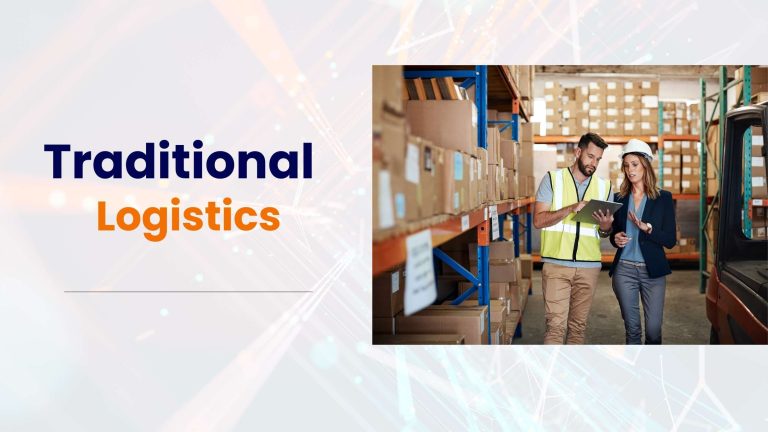Logistics and supply chain management are integral to how businesses deliver products and services from production to the end customer. Logistics deals with the coordination of the movement and storage of goods, including transportation, warehousing, and distribution. Supply chain management covers the broader process, including sourcing materials, production, and logistics.
Effective management in these areas can greatly enhance a company’s efficiency. Businesses can reduce their operational costs, improve delivery times, and maintain high levels of customer satisfaction by optimizing their logistics and supply chain. Efficient systems ensure that products are available when and where they are needed, which is crucial for meeting customer expectations and staying competitive.
Technology in logistics is important so they can automate their systems to increase the efficiency and effectiveness of supply chain and logistics.

Traditional Logistics and Supply Chain Practices
In traditional logistics and supply chain management, businesses relied heavily on manual tracking and paper-based processes. Here’s how these practices worked:
Manual Tracking:
This involved keeping track of goods and shipments by hand. Companies would use handwritten logs and forms to record details about inventory, order status, and transportation routes. Staff members manually updated these records each time there was a change, such as when new stock arrived or an order was shipped. This process required constant monitoring and updating to ensure accuracy.
Paper-Based Processes:
Much of the documentation was done on paper. This included purchase orders, shipping manifests, inventory lists, and invoices. All records were maintained in physical files and folders. For example, when an order was placed, a paper purchase order would be created and filed. Shipping details were also documented on paper and passed along to the warehouse and shipping departments. This paperwork had to be manually managed, filed, and retrieved as needed.
Common Challenges with Traditional Practices
Inefficiencies:
Manual tracking and paper-based processes were time-consuming. Staff had to manually enter data, search through files for information, and update records by hand. This often led to slower operations and increased chances of errors, as each manual step provided an opportunity for mistakes.
High Costs:
Managing physical records and manual processes requires a lot of resources. More personnel were needed to handle paperwork, and physical storage space was required for documents. The labor-intensive nature of these tasks also increased operational costs.
Lack of Real-Time Visibility:
With paper records and manual updates, obtaining up-to-date information on inventory levels and shipment statuses was difficult. There was often a delay between when data was recorded and when it was accessible, making it challenging to respond quickly to changes or disruptions in the supply chain.

Introduction to Technology in Logistics
Technology in logistics involves using digital tools and systems to enhance and streamline the processes of moving and storing goods. This includes various solutions designed to improve efficiency and accuracy.
Role of Technology in Logistics
Technology in logistics plays a significant role in optimizing logistics operations.
- Tracking: Digital tools such as GPS and RFID provide real-time information on the location and status of shipments, improving visibility and accuracy.
- Inventory Management: Advanced software helps manage inventory by tracking stock levels, forecasting demand, and automating stock control.
- Automation: Automated systems handle repetitive tasks like sorting and packing, which speeds up operations and reduces the potential for human error.
Reasons for Integrating Technology into Logistics
- Improved Accuracy: Automated systems and digital tools enhance precision by reducing manual data entry errors, leading to more reliable information about inventory and shipments.
- Increased Speed: Technology speeds up processes such as order fulfillment and shipment tracking, allowing for faster decision-making and quicker responses to customer needs.
- Enhanced Customer Satisfaction: Real-time updates and efficient service from automated systems improve reliability and customer communication, leading to higher satisfaction levels.
Key Technologies Transforming Logistics and Supply Chain Management
Managing everyday logistics and supply chain tasks manually can be hectic and overwhelming. You need to be aware of these technologies and how to use them in managing logistics and supply chains without manual interruption to increase efficiency.
Internet of Things (IoT)
IoT connects various devices and systems through the internet, enabling them to communicate and share data. In logistics, IoT devices are used to streamline operations by providing real-time information.
- Tracking Shipments: IoT sensors track the location and condition of shipments, allowing businesses to monitor goods as they move through the supply chain.
- Monitoring Inventory: IoT technology helps manage inventory levels by providing real-time updates on stock quantities and locations.
- Enhancing Supply Chain Visibility: IoT devices offer greater visibility into the supply chain, enabling companies to see the status of shipments and inventory at any given moment.
Artificial Intelligence (AI) and Machine Learning (ML)
AI refers to computer systems that can perform tasks that typically require human intelligence, such as understanding language or recognizing patterns. ML is a subset of AI where systems learn from data and improve their performance over time without being explicitly programmed.
- Predicting Demand: AI and ML analyze historical data to forecast future demand, helping companies manage inventory and plan production.
- Optimizing Routes: These technologies optimize delivery routes, reducing travel time and costs in fleet management.
- Automating Repetitive Tasks: AI and ML can automate routine tasks such as data entry and order processing, leading to more efficient operations.
Blockchain Technology
Blockchain is a digital ledger that records transactions across a distributed network. Each transaction is encrypted and linked to the previous one, creating a secure and transparent record.
- Ensuring Secure Transactions: Blockchain technology ensures that transactions are secure and tamper-proof, which helps prevent fraud and errors in the supply chain.
- Promoting Transparency: It provides a clear and unchangeable record of all transactions, improving trust and accountability across the supply chain.
Robotics and Automation
Robotics involves using robots to perform tasks that would otherwise be done by humans. In logistics, robots are increasingly used in warehouses and distribution centers.
- Improving Efficiency: Robots handle tasks like picking, packing, and sorting, which speeds up operations and reduces human error.
- Reducing Errors: The use of robots and automated systems ensures greater precision in handling goods, minimizing mistakes, and increasing overall efficiency.
Big Data and Analytics
Large and complicated datasets that are beyond the capabilities of conventional data processing technologies are referred to as “big data.”
- Importance in Logistics: Big data analytics is crucial for understanding and optimizing supply chain operations.
- Informed Decisions: By analyzing vast amounts of data, businesses can make better decisions about inventory management, supply optimization, and overall supply chain performance.

Benefits of Using Technology in Logistics
Improved Efficiency
Technology in logistics enhances operational efficiency by streamlining processes. Automated systems reduce the time needed for tasks such as inventory management and order processing while minimizing errors. This leads to smoother and quicker operations, improving the overall flow of goods through the supply chain.
Cost Savings
Automation and data-driven strategies contribute to substantial cost reductions. By utilizing automated systems, businesses can cut down on labor expenses and decrease the costs associated with manual handling. Additionally, data-driven insights help with supply optimization, allowing for more efficient resource allocation and better management of fleet management.
Enhanced Accuracy
Technology in logistics boosts the precision of inventory management and shipment tracking. Advanced tools provide accurate and real-time data, which helps to minimize mistakes that occur with manual tracking. This results in better control over inventory levels and more reliable shipment processes.
Better Customer Service
Real-time tracking and expedited delivery are key benefits of integrating technology in logistics. Customers gain access to up-to-date information about their orders, which improves their overall experience. Faster deliveries made possible through optimized routing and efficient systems lead to higher customer satisfaction and loyalty.

Challenges in Adopting Technology
Initial Costs
Adopting new technology in logistics often involves high initial costs. Investing in advanced systems and infrastructure can be expensive, including the purchase of equipment and software. These upfront financial barriers can be a significant obstacle for many organizations, especially small to medium-sized enterprises.
Complexity of Integration
Integrating new technology with existing systems can be complex. Businesses may face challenges in making new tools and systems work seamlessly with their current processes and infrastructure. This integration process requires careful planning and coordination to ensure that all systems operate together efficiently.
Data Security Concerns
With the increased use of technology comes the need for strong data security measures. Protecting sensitive information from cyber threats is essential in a tech-driven logistics environment. Ensuring that data is secure and managing risks related to breaches or data loss is a critical concern for companies adopting new technologies.
Need for Skilled Workforce
Implementing new technologies requires a workforce skilled in operating and managing these systems. Training and upskilling employees is necessary to effectively use advanced tools and ensure that staff can handle new technologies. This requirement adds an extra layer of complexity and cost to the adoption process.
Real-world Examples of Technology in Logistics
These are some real-world examples that will help you understand why technology in logistics is important in the modern world and how it can increase the efficiency of your business.
Amazon
Amazon leverages technology in logistics to efficiently manage its extensive network of warehouses and distribution centers. The company uses advanced automated systems for sorting and packing orders. Robotics are employed to move items within warehouses, and sophisticated software helps in tracking inventory and optimizing delivery routes. Technology in logistics at Amazon ensures that products are quickly located, picked, and shipped, supporting their fast delivery promises to customers.
DHL
DHL integrates robotics and AI into its supply chain operations to enhance efficiency and accuracy. Robotics are used in warehouses for tasks like sorting and handling packages, which speeds up processing times and reduces errors. AI systems analyze data to optimize delivery routes and predict demand, improving overall logistics operations. By combining these technologies, DHL streamlines its supply chain processes and maintains high levels of service.

The Future of Technology in Logistics
Emerging Technologies
New technologies such as 5G and autonomous vehicles are shaping the future of logistics. 5G provides faster and more reliable communication between devices, which enhances real-time tracking and improves coordination across the supply chain. Autonomous vehicles, including drones and self-driving trucks, promise to transform fleet management by reducing delivery times and increasing efficiency in transportation.
Sustainability through Technology
Future technologies are expected to support more sustainable logistics practices. Innovations such as electric delivery vehicles and smart routing systems help reduce carbon emissions. By integrating these technologies, businesses can enhance supply optimization and minimize their environmental impact, contributing to greener logistics operations.
Continual Evolution
Technology in logistics is continuously advancing. As new tools and systems are developed, ongoing improvements are anticipated. These advancements will further enhance efficiency, accuracy, and sustainability in logistics, leading to more effective and innovative practices in the industry.
The Bottom Line
Technology in logistics is reshaping supply chain management through innovations like automated systems, AI, and IoT, which enhance efficiency, lower costs, and improve customer service. These advancements aid in supply optimization and streamline fleet management, transforming how goods are managed and transported. The adoption of new technologies presents challenges such as high initial expenses, integration issues, the need for a skilled workforce, and concerns about data security. Continuous advancements are expected to make logistics operations more effective and responsive.
